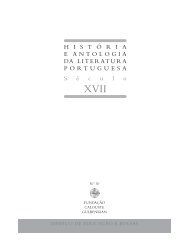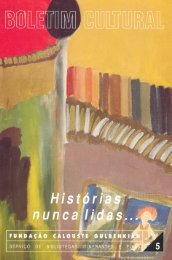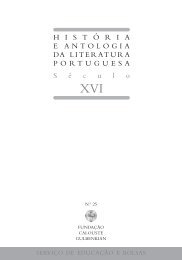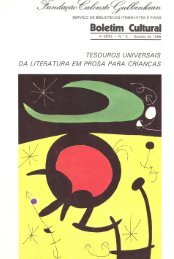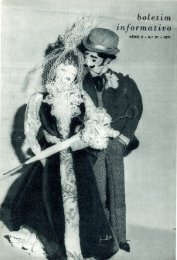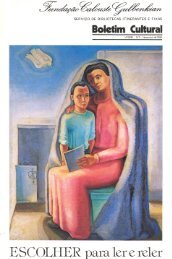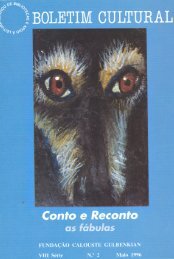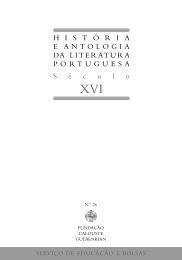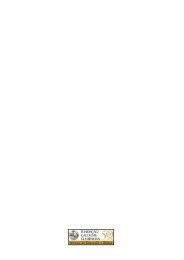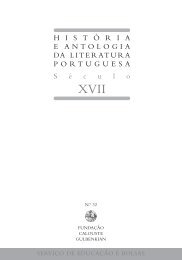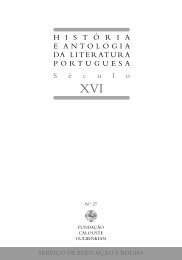Formar Leitores para Ler o Mundo - Leitura Gulbenkian - Fundação ...
Formar Leitores para Ler o Mundo - Leitura Gulbenkian - Fundação ...
Formar Leitores para Ler o Mundo - Leitura Gulbenkian - Fundação ...
Create successful ePaper yourself
Turn your PDF publications into a flip-book with our unique Google optimized e-Paper software.
72<br />
«A Children’s Writer with Adult Topics» is the title of an article devoted<br />
to Philip Pullman, but it could be applied equally well to many contemporary<br />
children’s authors who no longer offer the traditional fare of children’s<br />
books. 22 Tormod Haugen’s Vinterstedet (The Winter Place), published<br />
in Norway in 1984, is a powerful novel about suicide. The award-winning<br />
1994 novel Vallen (Falling), by the Flemish author Anne Provoost, addresses<br />
xenophobia and racism. Boike You Better Believe It, by the South African<br />
author Dianne Hofmeyr, deals with important issues, including terrorism,<br />
without the least trace of «writing down» to her audience, claimed<br />
the convener of the panel of judges when she won the Sanlam Gold<br />
Award for Youth Literature in 1994. 23 The American Meg Rosoff’s bestseller<br />
How I Live Now is a powerful story about young people caught up in<br />
the horrors of war. The Australian author, John Marsden, addresses the<br />
same topic in his hugely popular Tomorrow series, which opened in 1993<br />
with Tomorrow, When the War Began. Although Britain’s third Children’s<br />
Laureate, Michael Morpurgo, says he does not like the crossover tag, his<br />
work nonetheless has adult appeal, due to the serious themes of novels<br />
such as Kensuke’s Kingdom (1999), which deals with the aftermath of the<br />
Nagasaki bombing. The horrors of the Holocaust are the subject of Robert<br />
Cormier’s Tunes for Bears to Dance to (1992) and, more recently, Markus<br />
Zusak’s The Book Thief (2006). The Dominican-American author Julia<br />
Alvarez describes her children’s novel Before We Were Free (2002), set during<br />
the repressive regime of El Jefe, Rafael Trujillo, as The Diary of Anne<br />
Frank for the Latin American crowd. Although the author initially questioned<br />
the appropriateness of writing about torture for a young audience,<br />
she eventually decided that since it was part of life, it should be<br />
written down. 24 It has been suggested that Lian Hearn’s Tales of the Otori<br />
novels, which include sexuality, rape, violence, homosexuality, sadism,<br />
and torture, break with the children’s literature model, but they are certainly<br />
not the first to do so. Although these themes are treated in a<br />
restrained manner, they give Hearn’s novels their adult feel. The same<br />
can be said of the way in which the Quebecois author Dominique Demers<br />
deals with attempted rape and cannibalism in Maïna, a novel published<br />
simultaneously for both adolescents and adults in 1997. The fact that<br />
there are very few, if any, taboo subjects in contemporary literature for<br />
young readers blurs the distinction between children’s and adult fiction,<br />
and facilitates the crossover in both directions. A similar situation existed<br />
prior to the creation of a se<strong>para</strong>te literature for children. Maurice<br />
Sendak points out that the tales collected by the Grimm brothers appeal<br />
to all ages because they are «about the pure essence of life – incest, murder,<br />
insane mothers, love, sex». 25<br />
The best fiction, regardless of the target audience, nourishes our desire<br />
for a fulfilling narrative while simultaneously providing more profound<br />
food for thought. Mike Bryan of Penguin International believes that the<br />
most successful crossovers offer «corking good escapist fun», but he<br />
insists that they also contain «serious messages about values». 26 Crossover<br />
authors agree that writing for children allows them to address the fundamental<br />
issues they feel strongly about and to engage in weighty psychological<br />
and philosophical reflections. Whereas Myerson states categorically<br />
that a children’s novel cannot provide «truths about human<br />
life» or «psychological understanding», many crossover authors believe<br />
that they are, in fact, the only books that can 27 . Pullman explains why he<br />
writes for children: «Children’s books still deal with the huge themes<br />
which have always been part of literature – love, loyalty, the place of religion<br />
and science in life, what it really means to be human. Contemporary<br />
adult fiction is too small and too sterile for what I’m trying to do.» 28<br />
William Nicholson agrees: «Issues of God and heaven, life and death, are<br />
central to our lives but [as adults] we’re shy of talking about them. When<br />
you write for children, though, you can go roaring into these incredibly<br />
important stories.» 29<br />
The huge success of a few super crossover books raised the profile of children’s<br />
literature and gave it an entirely new status. The significance of<br />
J.K. Rowling’s achievement in the age of multimedia is formulated in the<br />
following terms by Julia Eccleshare: «For the first time since the arrival of<br />
other mass media, a series of children’s books is holding a cultural position<br />
that is a match for [I would say more than a match for] a series such<br />
as Friends or Neighbours, something that had seemed unimaginable in an<br />
era in which reading, and children’s reading in particular, is not especially<br />
highly valued beyond the level of a functional literacy.» 30 Children’s literature,<br />
children’s authors, and the child reader have gained a new<br />
respect in the literary world and are enjoying a much higher profile in<br />
the media. Children’s authors have been acknowledged as some of the<br />
world’s most influential people. In November 2006, the European edition<br />
of Time magazine included Rowling, along with names like Mother<br />
Theresa and Nelson Mandela, in their special issue «60 Years of Heroes»<br />
because: «In a time when everything comes to us in bits and bytes,<br />
Rowling has made storytelling cool again.» 31 Harry Potter turned millions<br />
of children hooked on video games and television into avid readers, singlehandedly<br />
lowering the illiteracy rate worldwide. Although Rowling’s<br />
media superstar status has overshadowed other writers, she is not alone.<br />
In 2005, after Dragon Rider became the longest-running New York Times<br />
number one bestseller since Harry Potter, Time magazine put Cornelia<br />
Funke on its «Time 100» list of «the world’s most influential people».<br />
Children’s authors are finally being recognized, far beyond the children’s<br />
book sphere, or even the literary world, for the significant role they play<br />
in creating readers and citizens to understand the world.<br />
73




